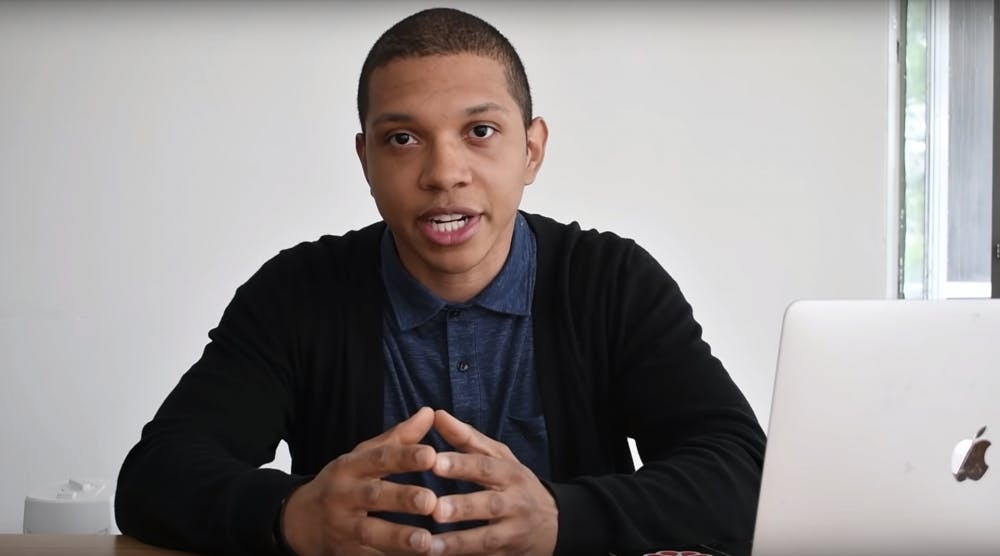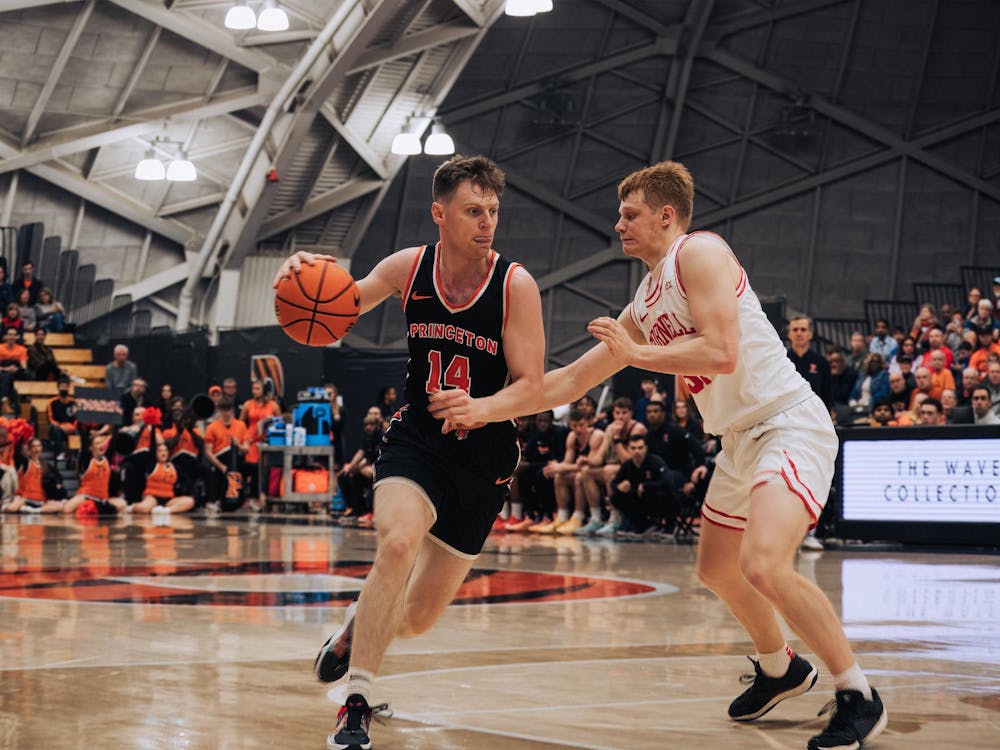AJ Sibley ’19 just wanted to finish his final paper. Sibley had spent hours staring at small black text on his computer screen. On a word document, he changed “can’t” to “cannot” and back again. He added and removed commas.
Finally, he was finished. It was January, and there was fresh snow on the ground. After being holed up in his dorm, Sibley was eager to get outside. But when he stepped out into the sunlight, he found the reflection of the rays on the snow intolerable. His eyes blazed with pain; he donned sunglasses to be able to see. Thinking that the sensation was only temporary, he pushed the incident out of his mind and tried to watch a movie. But the discomfort of looking at a screen was unbearable. The next day, Sibley called his parents. Something was wrong.
Jonathan Cortez ’16 had been working alongside Sibley when it happened four years ago.
“We were roommates, teammates, best friends,” Cortez said. “He went a day without sleep. It wasn’t irregular; it was something we’ve all done at some point. But that time, it was too much.”
In February of this year, Sibley sent an email to residential college listservs with the subject line “Don’t Be Me. Graduate on Time!” Sibley warned readers about the dangers of too much screen time and offered suggestions for preserving your vision, including inverting the display colors on your computer and following the 20-20-20 rule: for every twenty minutes of staring at a screen, look twenty feet away for twenty seconds.
“Computers are seriously damaging your eyes,” the email read. “I fried mine out from my Princeton study habits, and had to take three years off, as I can basically no longer use computers.” The onset was acute, and unexpected, he wrote. “I was completely fine looking at screens for 19 years, until the literal day I wasn’t.”
Recently, he authored a referendum urging the University administration to establish an annual health awareness initiative to educate students about the dangers of screen use. The referendum, which also includes a provision for installing blue light protection software on campus computers, passed on April 19.
Since that day his junior year, Sibley has been suffering with what he describes as “severe photophobia,” or extreme sensitivity to light. After the incident, he went back home to start an internship with a district attorney. He had already been planning a year off from school for financial reasons and used that time to visit as many doctors as he could. Sibley was subjected to a battery of tests for glaucoma, myopia, and other common problems. The first four ophthalmologists saw nothing wrong with his vision. Doctor Number Five, however, gave him a diagnosis – meibomian gland dysfunction.
The meibomian glands, of which there are approximately fifty on the upper eyelid and twenty-five on the lower eyelid, supply meibum, an oily substance that coats the eyeball and prevents tears from evaporating. Dysfunction of the meibomian gland causes dry eye, which can lead to pain and photophobia. The condition typically affects postmenopausal women with hormonal imbalances, and the doctor was surprised to find it in a young man like Sibley. She recommended he try LipiFlow, a procedure that essentially places a suction cup on your eyelid. The suction cups apply heat and pressure to break apart the waxy coagulations clogging the glands. The effects were drastic.
“My eyes went from zero percent to seventy percent,” Sibley said. “I went from having to wear two sunglasses indoors to not needing sunglasses outdoors.”
By the following spring, Sibley felt he had recovered enough to return to the University. But going back to the routine of writing papers and researching articles on a computer screen worsened his still-fragile condition. His eyes went from a seventy to a “negative fifty percent,” Sibley said. He realized that the issue went beyond his meibomian glands and was not going to be resolved easily. “I’ve got to leave and be willing not to come back until I can fix this,” he told himself at the end of the semester.
In the next two years, Sibley went across the country seeing doctors. In all, he would see a total of fourteen ophthalmologists. Most of them found no abnormalities and concluded that his eyes were fine. Some believed that his photophobia could not have been induced by light from screens and suggested a variety of largely ineffective treatments. Sibley tried LipiFlow again, but the second round did “literally nothing,” he said.

Sibley was beginning to lose hope when he came across a few research papers by one of the top eye doctors in the country. Rather than using the traditional slit-lamps to examine patients, this doctor employed an in vivo confocal microscope, a special device that allowed him to see microscopic damage to the cornea – the clear front part of the eye that covers the pupil and iris.
This doctor diagnosed him with corneal neuralgia, a catch-all term that covers a range of symptoms including photophobia and eye pain. According to the American Academy of Ophthalmology, corneal neuralgia is often mistaken for dry eye and is frequently dismissed by physicians who see nothing in the physical exam that could explain the severity of the symptoms. But with the special microscope, the doctor could see inflammation in Sibley’s cornea, as well as swelling in his optic nerve. He prescribed some eyedrops and predicted there would be drastic improvements in Sibley’s vision.
There were little to none. Sibley was crushed. Half-jokingly, with a melodramatic air, he paraphrased the famous quote from the Count of Monte Cristo: “The heart breaks when, after elated by flattering hopes, it sees all of its illusions destroyed.” He continued, “it hit me that this is probably going to be a lifelong situation, and I really need to figure out a way to live with it.”
Around this time, Sibley began reaching out to disability associations, searching for ways to continue his studies without exacerbating his photophobia. Eventually, he realized that the best course forward was to do whatever was necessary to graduate, even if that meant hiring aides or accepting less than ‘A’ grades. The University’s Office of Disability Services was very accommodating, Sibley said, enabling him to return to school in the fall. This marked two years since he was forced to leave.
Soon after, one of his classmates mentioned that his father was an ophthalmologist at the University of Utah. Sibley began communicating with his classmate’s father over the phone. For Sibley, this was a breakthrough – the new doctor truly seemed to care about him and listened intently to his story. From him, Sibley learned of an experimental treatment that involved using as eyedrops a substance isolated from his own blood – known in medical parlance as autologous blood serum. Sibley now performs the treatment ten times a day and keeps containers of his serum in the freezer. Since he started the therapy three months ago, he has noticed marked improvements, the first he has experienced in years.
Despite this, Sibley still cannot look at a screen without pain, and continues to wear sunglasses in and out of doors. He uses a typewriter and relies on dictation software to compose papers for class. Assistants, fellow students hired by the Office of Disability Services, read him his texts, emails, and Google searches. It has been difficult, Sibley said, to come to terms with the fact that his grades are no longer dependent on his work alone but also on that of a third party.
Although having an assistant has been a major adjustment, Sibley is thankful for the support and opportunities he has been given. During his two-year leave of absence, he worked as a staffer for several political campaigns, including one summer with Hillary Clinton’s. The job fit well with his talents and his disability, Sibley said. While other members of the team took care of the spreadsheets and data-crunching, he was able to speak to voters and interact with people on the ground.
“I don’t know how I would have functioned without having that meaningful work to keep me occupied,” he said.
Sibley wants to prevent other students from going into the same downward spiral, because, he said, this could easily happen to anyone. In his email, Sibley identified blue light coming from screens as a likely trigger for his eye problems. According to a 2018 study from the University of Toledo, blue light initiates chemical reactions in the eyes’ photoreceptors, releasing poisonous compounds that kill cells and lead to vision loss. As such, he advocates wearing special glasses that filter out blue light, and turning on night shift, which tints screens to a warm orange-red.
Sibley’s condition has made him crepuscular. “My favorite times of day are dawn and dusk,” he said. In the past few weeks, cherry blossoms have begun blooming outside his suite, and he has “stopped to smell the roses.” In the half-darkness, he can comfortably remove his sunglasses.
“I take them off and look at the brightness and richness of the colors,” he said. “It really makes me appreciate just being alive. It puts this in perspective. Yes, I might have to deal with this for the rest of my life, but I have so many incredible experiences that others don’t.”
“I just count my blessings and keep going.”









